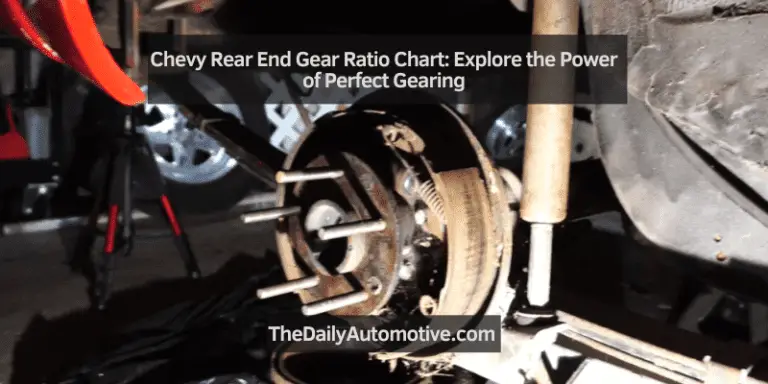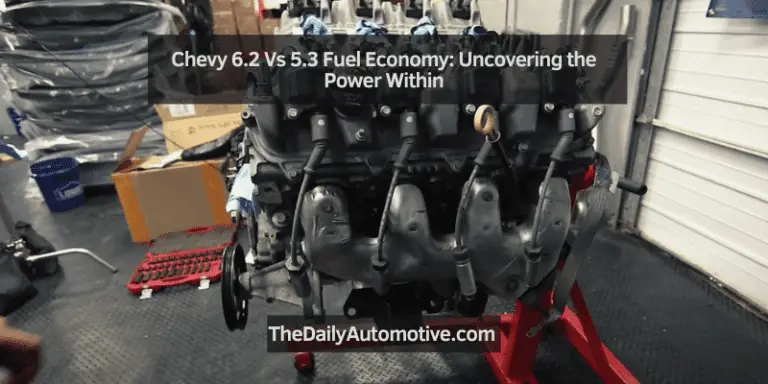Chevy 5.3 Vs 6.2: A Battle of Power
The chevy 5.3 and 6.2 engines have differences in power and performance. We will compare the two engines, highlighting their unique features and applications.
Whether you are considering a chevy vehicle with a 5. 3 or 6. 2 engine, understanding their differences will help you make an informed decision.
Understanding The Key Differences
The chevy 5. 3 and 6. 2 engines have key differences, including displacement and power output. Their varying characteristics make them suitable for different types of vehicles and driving preferences.
When it comes to choosing the right engine for your chevy vehicle, understanding the key differences between the 5. 3 and 6. 2 engines is crucial. These two engines offer unique performance specifications, power outputs, torque outputs, and fuel efficiency considerations.
Let’s delve into the details and explore how these engines differ.
Performance Specifications Of The Chevy 5.3 And 6.2 Engines:
The Chevy 5.3 engine:
- Horsepower output: The 5.3-liter v8 engine packs a punch with a horsepower output of up to 355 hp.
- Torque output: Delivering impressive torque, the 5.3 engine can generate up to 383 lb-ft, giving your vehicle the power it needs for acceleration and towing.
- Cylinders: This engine features eight cylinders, ensuring smooth and efficient performance.
- Compression ratio: The 5.3 engine boasts a compression ratio of 11.0:1, which contributes to its efficient power delivery.
The Chevy 6.2 engine:
- Horsepower output: With the 6.2-liter v8 engine, you can experience exceptional power with a horsepower output of up to 420 hp.
- Torque output: This engine is a beast when it comes to torque, offering an impressive maximum of 460 lb-ft, perfect for towing heavy loads and conquering tough terrains.
- Cylinders: The 6.2 engine also features eight cylinders, ensuring robust performance and smoother operation.
- Compression ratio: With a compression ratio of 11.5:1, the 6.2 engine maximizes power while maintaining fuel efficiency.
Power Output And Torque Comparison Between The Two Engines:
The Chevy 5.3 engine:
- Delivers strong power output, ideal for everyday driving needs.
- Provides ample torque to handle moderate towing and hauling requirements.
The Chevy 6.2 engine:
- Offers superior power output, perfect for those seeking exhilarating performance.
- Provides exceptional torque, enabling effortless towing and hauling of heavy loads.
Fuel Efficiency And Economy Considerations:
The Chevy 5.3 engine:
- Boasts impressive fuel efficiency, allowing you to save on gas expenses during everyday commutes and long drives.
- Offers a good balance between power and fuel economy, making it suitable for those who prioritize efficient fuel consumption.
The Chevy 6.2 engine:
- While slightly lower in fuel efficiency compared to the 5.3 engine, the 6.2 makes up for it with its outstanding power and performance capabilities.
- Ideal for those who prioritize power and performance over fuel economy.
Understanding the differences between the Chevy 5. 3 and 6. 2 engines can help you make an informed decision when selecting the engine that suits your specific requirements. Whether you prioritize power, torque, fuel efficiency, or a combination of these factors, Chevy has an engine that will meet your needs.
Evaluating The Engine Size
Evaluating the engine size of Chevy 5. 3 and 6. 2 provides insight into their power and performance capabilities. Choosing between these options requires considering factors like towing capacity and fuel efficiency. The 6. 2 engine offers more horsepower and torque, while the 5. 3 engine provides a balance of performance and efficiency.
Comparing The Engine Displacement Of The Chevy 5.3 And 6.2 Engines
The engine size plays a crucial role in determining a vehicle’s power and performance. When it comes to the Chevy 5. 3 and 6. 2 engines, there are distinct differences in their displacement. Let’s take a closer look at how these engine sizes compare:
Chevy 5.3 engine:
- This engine has a displacement of 5.3 liters, making it smaller than the 6.2 engine.
- It is known for its versatility and fuel efficiency, providing reliable performance for various driving conditions.
- With the 5.3 engine, you can expect a balanced combination of power and efficiency that suits everyday driving needs.
Chevy 6.2 engine:
- On the other hand, the 6.2 engine boasts a larger displacement of 6.2 liters.
- This engine is recognized for delivering more power and torque, making it ideal for towing heavy loads or demanding driving situations.
- The 6.2 engine is often favored by those seeking exceptional performance and a thrilling driving experience.
Impact Of Engine Size On Power And Performance
The engine size significantly influences a vehicle’s power and performance. Let’s explore how the size of the engine affects these aspects:
Power:
- Larger engine displacement, like the 6.2 liters in the Chevy 6.2 engine, generally results in more power output.
- Increased displacement allows for more air and fuel to be burned, generating higher horsepower and torque.
- In comparison, the 5.3 engine with its smaller displacement offers sufficient power for everyday driving needs.
Performance:
- The Chevy 6.2 engine’s larger size contributes to enhanced performance capabilities.
- It enables quicker acceleration, greater towing capacity, and improved overall responsiveness.
- While the 5.3 engine still provides satisfactory performance, its smaller displacement may limit its capabilities in more demanding situations.
Factors To Consider When Choosing Between The Two Engine Sizes
When selecting between the Chevy 5. 3 and 6. 2 engines, several factors should be taken into account. Consider the following aspects to make an informed decision:
Driving needs:
- Assess your typical driving requirements to determine the level of power and performance you require.
- If you frequently tow heavy loads or crave exhilarating acceleration, the 6.2 engine might be the better choice.
- For everyday commuting and occasional hauling, the 5.3 engine should suffice.
Fuel efficiency:
- Take into consideration the impact of engine size on fuel consumption.
- Generally, the smaller displacement of the 5.3 engine translates to better fuel efficiency.
- The 6.2 engine, with its larger displacement and higher power output, may have a slightly lower fuel economy.
Budget:
- Price can also be a deciding factor when choosing between engine sizes.
- The 6.2 engine is often available as an upgrade with higher trim levels, which may come at an additional cost.
- If budget is a concern, the 5.3 engine could provide a more affordable option without compromising on performance.
By evaluating the engine displacement, understanding the impact on power and performance, and considering individual needs and preferences, you can determine whether the Chevy 5. 3 or 6. 2 engine is the right choice for you. So, take these factors into account and make a decision that suits your driving style and requirements.
Exploring Performance Capabilities
The Chevy 5. 3 and 6. 2 engines offer exceptional performance capabilities. With their distinct characteristics, these engines ensure an exhilarating and powerful driving experience.
The performance capabilities of the Chevy 5. 3 and 6. 2 engines are what truly set them apart. Whether you’re looking for acceleration and top speed, towing and hauling power, or off-road performance and handling, these engines deliver outstanding results.
Let’s take a closer look at each aspect:
Acceleration And Top Speed Comparison Between The 5.3 And 6.2 Engines:
- The Chevy 5.3 engine offers impressive acceleration, allowing you to go from 0 to 60 mph in just a few seconds.
- With the 6.2 engine, you’ll experience even faster acceleration, thanks to its higher horsepower and torque.
- When it comes to top speed, the 6.2 engine takes the lead, providing a thrilling driving experience on the open road.
Towing And Hauling Capabilities Of Each Engine:
- The 5.3 engine is no slouch when it comes to towing and hauling. It offers a respectable towing capacity, making it ideal for light to moderate loads.
- If you need serious towing and hauling power, the 6.2 engine is the way to go. With its higher torque output, it can handle heavy loads with ease.
Off-Road Performance And Handling Differences:
- Both engines perform well in off-road conditions, thanks to their robust construction and advanced technology.
- The 5.3 engine provides reliable off-road performance, ensuring you can navigate rough terrain with confidence.
- When it comes to off-road handling, the 6.2 engine shines. Its enhanced power and torque allow for better traction and control, especially in challenging off-road environments.
The Chevy 5. 3 and 6. 2 engines offer impressive performance capabilities in different areas. Whether you prioritize acceleration and top speed, towing, and hauling power, or off-road performance, these engines deliver outstanding results. Whichever engine you choose, you can expect a thrilling driving experience that will meet your performance needs.
Assessing Fuel Efficiency
The fuel efficiency of the Chevy 5. 3 and 6. 2 engines are assessed to determine their performance in terms of saving fuel. These engines are compared to determine which one offers better fuel efficiency.
Chevy 5.3 Vs 6.2: Assessing Fuel Efficiency
When it comes to choosing between the Chevy 5. 3 and 6. 2 engines, fuel efficiency is a crucial factor to consider. Let’s delve into the fuel consumption of both engines, examine the factors that affect fuel efficiency, and understand the cost implications of any differences in fuel efficiency.
Fuel Consumption Of The Chevy 5.3 And 6.2 Engines
Here’s a breakdown of the fuel consumption of the Chevy 5. 3 and 6. 2 engines:
Chevy 5.3 engine:
- Fuel consumption: The 5.3 engine provides decent fuel efficiency, with an EPA-estimated rating of around 18 mpg in the city and 24 mpg on the highway.
- Suitable for: This engine is ideal for everyday commuting, long highway drives, and occasional towing needs.
Chevy 6.2 engine:
- Fuel consumption: The 6.2 engine is more powerful and offers impressive performance. However, it requires slightly more fuel due to its larger displacement and increased horsepower. Expect an EPA-estimated fuel efficiency rating of around 15 mpg in the city and 20 mpg on the highway.
- Suitable for: If you prioritize power and performance over fuel efficiency, the 6.2 engine is the way to go. It is a great choice for heavy towing, off-road adventures, and those who enjoy a thrilling driving experience.
Factors Affecting Fuel Efficiency In Each Engine
Several factors play a role in determining the fuel efficiency of the Chevy 5. 3 and 6. 2 engines:
- Engine size: The larger displacement of the 6.2 engine results in more fuel consumption compared to the 5.3 engine.
- Horsepower and torque: The increased power output of the 6.2 engine requires more fuel to sustain its performance capabilities.
- Vehicle weight: Heavier vehicles equipped with either engine tend to consume more fuel than lighter ones, impacting overall fuel efficiency.
- Driving style: Aggressive driving, frequent accelerations, and heavy loads can negatively affect fuel efficiency regardless of the engine.
Cost Implications Of Fuel Efficiency Differences
While the Chevy 5. 3 engine boasts better fuel efficiency than the 6. 2 engine, so it’s essential to understand the cost implications:
- Fuel expenses: The 6.2 engine’s larger displacement and higher fuel consumption may result in slightly higher fuel expenses compared to the 5.3 engine.
- Maintenance costs: Generally, the 5.3 engine may require less maintenance and have a longer lifespan due to its lower stress on components from reduced power output.
Keep in mind that fuel efficiency is just one aspect to consider when choosing between the Chevy 5. 3 and 6. 2 engines. Ultimately, your decision should align with your specific needs and priorities, whether it’s power, fuel economy, or a balance of both.
Remember, by carefully assessing the fuel consumption, understanding the factors that influence efficiency, and considering the cost implications, you’ll be better equipped to make an informed decision between the Chevy 5. 3 and 6. 2 engines. Happy driving!

Understanding The Cost Factors
Comparing the cost factors between the Chevy 5. 3 and 6. 2 engines can help you make an informed decision. These two options differ in price, offering various features and capabilities to suit different needs and budgets. Understanding the cost factors will empower you to choose between the Chevy 5. 3 and 6. 2 engines effectively.
If you’re in the market for a new Chevy truck, one of the key decisions you’ll have to make is choosing between the 5. 3 and 6. 2 engines. Both engines have their own advantages and considerations, and one important factor to keep in mind is the cost.
Let’s take a closer look at how the price difference, maintenance and repair costs, and resale value play into your decision-making process.
Price Difference Between The 5.3 And 6.2 Engines:
- The 5.3 engine is generally more affordable compared to the 6.2 engine, making it an attractive option for budget-conscious buyers.
- With its larger size and higher output, the 6.2 engine comes at a premium price point, providing enhanced power and performance.
Maintenance And Repair Costs For Each Engine:
- The 5.3 engine is known for its reliability and relatively low maintenance costs, making it an economical choice in the long run.
- The 6.2 engine, while powerful, may require higher maintenance expenses due to its more complex design and performance capabilities.
Resale Value Considerations:
- When it comes to resale value, the 6.2 engine can hold its worth much better than the 5.3 engine, making it a potentially better investment for those looking to sell or trade in their vehicle in the future.
- The 5.3 engine, although more affordable upfront, may depreciate faster than its 6.2 counterpart, affecting its resale value.
Understanding the cost factors involved in choosing between the Chevy 5. 3 and 6. 2 engines is crucial. While the 5. 3 engine offers affordability and reliability, the 6. 2 engine provides greater power and performance capabilities at a higher cost.
Consider your budget, anticipated maintenance expenses, and long-term resale value to make an informed decision that suits your needs and preferences.
Analyzing Real-World Performance
Analyzing real-world performance, the Chevy 5. 3 and 6. 2 engines showcase their differences. With each offering unique strengths, understanding their capabilities aids in making an informed choice.
Drivers and vehicle enthusiasts often consider engine performance to be a critical factor when deciding between different models. In the case of Chevy trucks, the 5. 3-liter and 6. 2-liter engines are two popular choices known for their power and capability.
By analyzing real-world performance and taking into account user experiences and feedback, we can gain valuable insights into each engine’s strengths and limitations.
User Experiences And Feedback On The Chevy 5.3 Engine
- Smooth acceleration: The Chevy 5.3 engine has been praised for its seamless and responsive acceleration, providing drivers with a satisfying boost of power when needed.
- Fuel efficiency: Users have reported that the 5.3-liter engine offers decent fuel efficiency, making it a practical choice for everyday commuting and long drives.
- Towing capabilities: Many users have tested the towing capabilities of trucks equipped with the 5.3-liter engine and have found it more than capable of handling heavy loads.
- Reliability: Users have commented on the reliability of the 5.3-liter engine, often highlighting its durability and longevity even with regular and demanding usage.
- Smooth operation: The 5.3-liter engine is known for its smooth and quiet operation, delivering a comfortable driving experience.
User Experiences And Feedback On The Chevy 6.2 Engine
- Power and performance: Drivers have expressed their satisfaction with the sheer power and performance delivered by the Chevy 6.2 engine. It offers impressive acceleration and a commanding presence on the road.
- Towing and hauling prowess: Users who regularly tow or haul heavy loads appreciate the 6.2-liter engine’s exceptional towing capabilities, making it ideal for heavy-duty tasks.
- High-end performance: The 6.2-liter engine is highly regarded for its ability to excel in high-performance situations, appealing to those seeking a more exhilarating driving experience.
- Fuel efficiency: While the 6.2-liter engine is predominantly known for its power, some users have mentioned that it may consume more fuel compared to the 5.3-liter engine.
- Reliability and durability: Users have consistently reported that the 6.2-liter engine is reliable and durable, withstanding extensive usage and delivering consistent performance.
Comparing Reliability And Durability Of Both Engines
- Reliable performance: Both the 5.3-liter and 6.2-liter engines have a reputation for reliability, as drivers have consistently experienced few issues with either one.
- Durability under demanding conditions: Users have subjected both engines to demanding conditions such as towing heavy loads and have found them to be resilient, showcasing their durability.
- Maintenance and longevity: Owners have mentioned that with regular maintenance and care, both engines can last for many years without sacrificing performance.
- Versatility: Whether it’s daily commuting or tackling tough jobs, both engines have proven themselves to be versatile and capable, meeting the demands of various driving scenarios.
User experiences and feedback shed light on the real-world performance of the Chevy 5. 3 and 6. 2 engines. The 5. 3-liter engine offers smooth acceleration, decent fuel efficiency, and impressive towing capabilities. On the other hand, the 6. 2-liter engine delivers exceptional power, towing prowess, and high-end performance.
Both engines demonstrate reliability, durability, and versatility, making them reliable options for different driving needs and preferences.
Choosing The Right Engine For Your Needs
Choosing between the Chevy 5. 3 and the 6. 2 engines depend on your specific needs. Consider factors like power, fuel efficiency, and intended usage to make the right decision for your vehicle.
Factors To Consider When Deciding Between The 5.3 And 6.2 Engines
When it comes to choosing the right engine for your Chevy, there are a few key factors to consider. The decision between the 5. 3 and 6. 2 engines can have a significant impact on your driving experience. Here, we will explore these factors and help you make an informed decision:
Personal Preference, Driving Habits, And Intended Use:
- If you prefer a more fuel-efficient engine, the 5.3 engine might be the better choice. It offers decent power and torque while delivering better gas mileage.
- On the other hand, if you crave a more aggressive and powerful driving experience, the 6.2 engine is the way to go. It provides additional horsepower and torque, perfect for those who enjoy exhilarating acceleration and towing capabilities.
- If you often haul heavy loads or trailers, the 6.2 engine’s higher torque and towing capacity make it the more suitable option.
- Consider your driving habits as well. If you frequently drive in hilly or mountainous areas, the added power of the 6.2 engine can make your drives easier and more enjoyable.
- Think about your intended use for the vehicle. If you primarily use it for daily commuting or light hauling, the 5.3 engine can be a practical and economical choice. However, if you plan to use your Chevy for off-road adventures or intense towing, the 6.2 engine might be more appropriate.
Examining The Overall Value Proposition Of Each Engine:
- The 5.3 engine offers a good balance between power, fuel efficiency, and affordability. It is a reliable option for most drivers.
- On the other hand, the 6.2 engine comes at a higher price point but delivers exceptional performance. It is a costlier investment upfront, but it provides a more thrilling driving experience and enhanced capabilities.
- Consider the long-term value. If you plan to keep your Chevy for many years, the 6.2 engine’s strong performance and towing capacity may justify the higher initial cost.
Ultimately, the decision between the Chevy 5. 3 and 6. 2 engines boil down to personal preference, driving habits, and intended use. Evaluate these factors carefully to ensure you choose the engine that best suits your needs. Remember, both engines offer their own benefits, and whichever one you choose, you’ll enjoy the power and performance that Chevy is renowned for.
Frequently Asked Questions Of Chevy 5.3 Vs 6.2
Does A 6.2 Really Need Premium Gas?
No, a 6. 2 engine does not necessarily require premium gas.
Is The Chevy 6.2 Engine Good?
The Chevy 6. 2 engine is highly regarded for its quality and performance. It provides excellent power and torque for a variety of applications. It is known for its durability and reliability, making it a great choice for both everyday driving and heavy-duty use.
With its advanced technology and efficient design, the 6. 2 engine delivers impressive fuel efficiency without compromising on power output. It is also compatible with various fuel types, including gasoline and flex-fuel options. Whether you’re hauling heavy loads or cruising on the highway, the Chevy 6.
2 engine ensures a smooth and powerful driving experience. With its solid reputation and proven track record, this engine is definitely a good choice for those seeking reliable and high-performing vehicles.
Is The Chevy 5.3 V8 A Good Engine?
The Chevy 5. 3 v8 is a reliable and efficient engine option. It offers solid performance and is known for its durability. With a power output of around 355 horsepower and 383 lb-ft of torque, it provides ample power for various tasks.
Its fuel economy is decent for a v8 engine, making it a practical choice for everyday use. The 5. 3 v8 is commonly used in trucks and SUVs, where its towing capabilities shine. It also features advanced technologies like direct fuel injection and cylinder deactivation, maximizing fuel efficiency.
Overall, the Chevy 5. 3 v8 is a trusted and well-regarded engine among enthusiasts and regular drivers alike.
Is The Tahoe 5.3 Or 6.2 In 2023?
In 2023, the Tahoe will be available with either a 5. 3 or 6. 2 engine. Both options offer reliable performance and power. Choose the 5. 3 for a solid performance, while the 6. 2 offers enhanced power. The Tahoe is designed to provide a comfortable and enjoyable driving experience.
Conclusion
Overall, both the Chevy 5. 3 and 6. 2 engines have their unique strengths and it ultimately comes down to your specific needs and priorities. The 5. 3 engine offers a balance of power and fuel efficiency, making it a practical choice for everyday driving.
On the other hand, the 6. 2 engine delivers more horsepower and torque, providing a thrilling driving experience for those who crave power and performance. It’s also important to note that the 6. 2 engine is typically found in higher-performance trims and may come with a higher price tag.
If you’re looking for a budget-friendly option, the 5. 3 engine may be the better choice. Additionally, factors such as towing capacity, payload, and fuel economy should be considered when making your decision. Whether you opt for the Chevy 5.
3 or 6. 2 engine, you can expect a reliable and powerful performance. Consider your driving needs, budget, and desired level of performance to determine which engine is the right fit for you. So, weigh your options and make a well-informed decision based on what matters most to you.
Happy driving!








